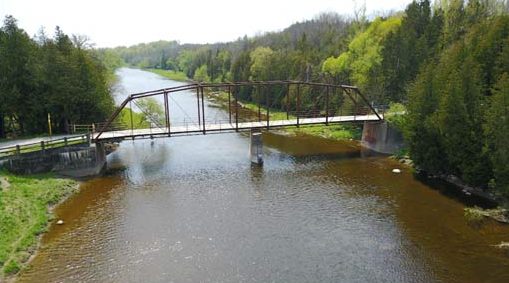ELORA – Centre Wellington council voted at the committee of the whole meeting on Nov. 22 to reconsider its earlier decision to demolish the Middlebrook Place bridge.
That does not mean the bridge is saved. But it does mean that township staff will reach out to Woolwich Township and see if that municipality is willing to revisit the matter.
The bridge spans the Grand River and joins the two municipalities at Middlebrook Road in Centre Wellington and Weisenberg Road in Woolwich. As such, the two townships also share maintenance and repair costs.
In 2020, both councils decided to demolish the bridge, which is in poor repair and has been closed to vehicular traffic for many years.
Cyclists and hikers, however, used the bridge regularly and only realized its fate this spring, when barricades were put on both ends of the bridge, blocking its use for all users.
A user-group formed – Save Middlebrook Bridge Community Action Group – representing the many cycling groups and hiking clubs that use the bridge and delegated to both councils this fall to reconsider the decision to demolish.
On Nov. 22, Centre Wellington councillor Kirk McElwain spoke of the virtues of physical activity and active transportation and the economic windfall these groups add to the local economy.
He spoke about other potential funding sources that could be tapped and the possibility that user groups might be willing to contribute as well.
And he said the difference in cost between removing or rehabilitating the bridge – $700,000 to demolish and $900,000 to rehabilitate – is a nominal $200,000 by his calculation.
“That’s not a huge investment for a historic bridge,” McElwain said.
Other figures were tossed around during discussion.
McElwain said the life-cycle cost of rehabilitating the bridge was $1.6 million, which, again, is not much when spread over 30 years.
“I don’t understand why the numbers are scary for anyone,” he said.
Adam Gilmore, manager of engineering, had prepared a report with high-level costing of alternatives for the bridge based on the municipal class environmental assessment study, but couldn’t present his findings until council voted on a motion to reconsider.
A motion to reconsider requires a two-thirds majority, meaning five of the seven councillors would have to agree.
Councillor Steven VanLeeuwen wanted to be very clear on that point.
“Reconsideration does not mean approval to reconstruct,” he said.
Only Mayor Kelly Linton and councillor Neil Dunsmore voted against that motion, so reconsideration is now on the table.
Gilmore was then able to present his report and said the costs have been revised to 2021 dollars:
- removal, $720,000;
- rehabilitate for pedestrian/cycling use, $1.6 million; and
- replace bridge for pedestrian/cycling use, $1.2 million
Removal is slated for 2028 and the costs are to be split between Centre Wellington and Woolwich. These are lifecycle costs, estimated to be 30 years. There is no additional lifecycle cost for removing the bridge.
VanLeeuwen thought the user group should come up with an engineered option to retain the bridge and bring those figures to council.
“I can’t see why the cycling community wouldn’t be willing to do some leg work,” he said.
“I think the first step should be to approach Woolwich again,” McElwain said. “If they say no, it’s a different ballpark.”
None of the councillors wanted Centre Wellington to bear the entire cost of replacing the bridge.
In the end, council voted to refer the matter to staff to reach out to Woolwich again and see if that council is willing to revisit the bridge decision.
Stephanie Lines-Toohill was one member of the citizen’s group that delegated to council in October.
In an interview after the meeting, she said she was delighted that Centre Wellington council will take another look at the bridge.
“We have a long way to go but this is a positive start,” she said.
Lines-Toohill didn’t think much of VanLeeuwen’s suggestion that citizens should come up with a design and funding for the bridge themselves, though she believes there is a will within the group to raise some money if it means the bridge can be saved.
She said the next step is for cyclists, fishers and hikers who use the bridge to write to Woolwich councillors and let them know how important the bridge is.
“It is most important now that citizens reach out to Woolwich council and ask them to reconsider their decision,” Lines-Toohill said.
“Generations of people have used the bridge – it’s like a family member. But I don’t think council has heard those voices.”
Bridge 16WG
Council also approved a staff recommendation to replace Bridge 16WG, which spans Irvine Creek on 5th Line north of Wellington Road 19.
This bridge was built in 1910 and 2012 inspections revealed the structure was shifting. In 2017 a five-ton load restriction was imposed and in 2021 the bridge was closed.
Detailed design work is to occur in 2022 and construction in 2023.




